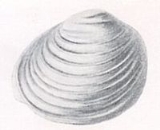
Pisidium clessini
Encyclopedia
Pisidium clessini is a species of extinct
freshwater bivalve from family Sphaeriidae
.
has an oval form with somewhat prominent umbo, that is situated behind the middle. There is a distinct concentric rib structure. The ribs are sharp and are separated by relatively big spaces. There are two (sometimes three) strong accentuated ribs near the Umbo, that gradually become less accentuated to the sides. These ribs are a distinct characteristic of the species. The ribs can be faded in certain cases, but the accentuated ribs are always there. Radial ribs are not present. The inner rim of the shell is smooth and is not crenulated.
The shell of this species has a somewhat variabel shape and sometimes does look a lot like Pisidium amnicum
.
Measurements of the shell:
, but mainly during interglacials of the early and middle Pleistocene
.
Extinction
In biology and ecology, extinction is the end of an organism or of a group of organisms , normally a species. The moment of extinction is generally considered to be the death of the last individual of the species, although the capacity to breed and recover may have been lost before this point...
freshwater bivalve from family Sphaeriidae
Sphaeriidae
The Sphaeriidae are a family of small to minute freshwater bivalve molluscs, in the order Veneroida. In the USA they are commonly known as the pea clams and the fingernail clams.-Genera:Genera in the family Sphaeriidae include:* Musculium...
.
Description
The shellBivalve shell
A bivalve shell is part of the body, the exoskeleton or shell, of a bivalve mollusk. In life, the shell of this class of mollusks is composed of two parts, two valves which are hinged together...
has an oval form with somewhat prominent umbo, that is situated behind the middle. There is a distinct concentric rib structure. The ribs are sharp and are separated by relatively big spaces. There are two (sometimes three) strong accentuated ribs near the Umbo, that gradually become less accentuated to the sides. These ribs are a distinct characteristic of the species. The ribs can be faded in certain cases, but the accentuated ribs are always there. Radial ribs are not present. The inner rim of the shell is smooth and is not crenulated.
The shell of this species has a somewhat variabel shape and sometimes does look a lot like Pisidium amnicum
Pisidium amnicum
Pisidium amnicum is a species of very small freshwater clam. It is sometimes known as the greater European peaclam, an aquatic bivalve in the family Sphaeriidae.-Description:...
.
Measurements of the shell:
- length: up to 7,8 mm.
- width: up to 6,5 mm.
- semi diameter: up to 2,2 mm.
Distribution
The species is extinct, but was widely spread in the whole of Europe from the beginning of the PliocenePliocene
The Pliocene Epoch is the period in the geologic timescale that extends from 5.332 million to 2.588 million years before present. It is the second and youngest epoch of the Neogene Period in the Cenozoic Era. The Pliocene follows the Miocene Epoch and is followed by the Pleistocene Epoch...
, but mainly during interglacials of the early and middle Pleistocene
Pleistocene
The Pleistocene is the epoch from 2,588,000 to 11,700 years BP that spans the world's recent period of repeated glaciations. The name pleistocene is derived from the Greek and ....
.

